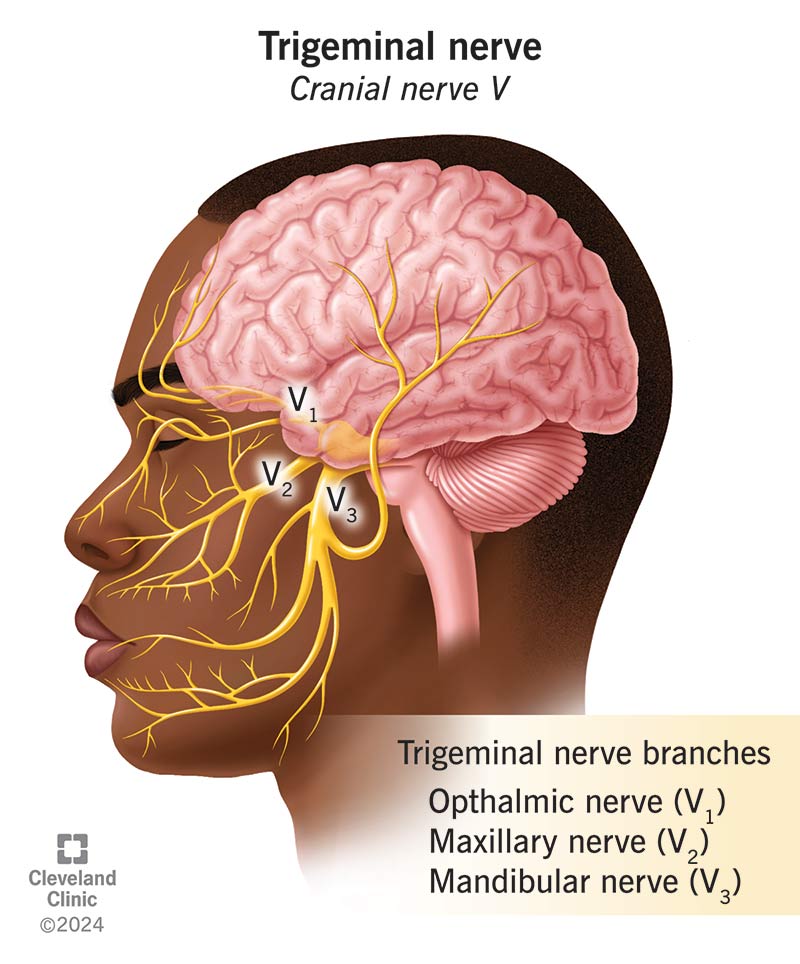Your trigeminal nerves help your face recognize pain and touch sensations, as well as heat and cold. The nerves also help you chew. Due to their large size and various functions, damage to your trigeminal nerves can cause a range of symptoms.
Advertisement
Cleveland Clinic is a non-profit academic medical center. Advertising on our site helps support our mission. We do not endorse non-Cleveland Clinic products or services. Policy

Your trigeminal nerve, also known as cranial nerve 5 or CN V, is a large, three-part nerve in your head that sends signals from your brain to parts of your face, and vice versa. You have two trigeminal nerves — one on each side of your face. They’re one set of 12 cranial nerve pairs. Your trigeminal nerve is the largest of the cranial nerves.
Advertisement
Cleveland Clinic is a non-profit academic medical center. Advertising on our site helps support our mission. We do not endorse non-Cleveland Clinic products or services. Policy
Your trigeminal nerve is an important nerve that provides sensation to large parts of your face and allows you to chew food. But you may not think about your trigeminal nerve unless you or someone you know has trigeminal neuralgia — a condition that causes episodes of intense facial pain.
Your trigeminal nerve provides motor (movement) and sensory information for different aspects of your head and face. Motor nerve fibers tell your muscles when and how to move. Sensory nerve fibers send pain, touch and temperature sensations from your skin to your brain.
Your trigeminal nerve consists of three branches:
Each of the three branches has different functions.
“Ophthalmic” means “eye.” The ophthalmic nerve branch provides sensory information for your face and skull in the opening between your eyelids of each eye (palpebral fissure). It also provides sensation for portions of your nasal cavity.
Sympathetic nerve fibers of this nerve branch play a role in dilating your pupils and supply sensation to the following parts of your eyes:
“Maxillary” refers to your upper jaw. This nerve provides sensory information for portions of your:
Advertisement
“Mandibular” refers to your lower jaw. This nerve branch is the largest of the three and has both sensory and motor fibers. It provides sensory innervation of:
The motor portion provides movement information to all the muscles involved in chewing (mastication). These include your:
Your mandibular nerve also plays a role in swallowing by supporting your digastric muscle and mylohyoid muscle.
You have two trigeminal nerves, one on each side of your head. They start in your brain and travel throughout your head, splitting into three branches.
The structure (anatomy) of your trigeminal nerves resembles tree branches extending from your brain throughout your face. Here’s what that looks like:
Several conditions and situations can affect the functioning of your trigeminal nerve, like:
Specific conditions related to issues with your trigeminal nerve include:
Advertisement
Treatment for trigeminal nerve issues depends on the underlying cause. Your trigeminal nerve can often recover from minor damage with time. In rare cases, you may need surgery to reconnect severed nerves. Some people need a nerve graft to replace the damaged nerve with a healthy one.
The symptoms of trigeminal nerve damage vary significantly due to the large size of the nerve and its various functions. A trigeminal nerve injury may affect a small area (like part of your gum) or a large area (like one side of your face). It depends on where the nerve has damage.
Examples of signs and symptoms of trigeminal nerve damage include:
See a healthcare provider if you have any of these symptoms.
You can’t always prevent trigeminal nerve damage. But these steps can help keep your nervous system — including your trigeminal nerve — healthy:
Advertisement
You can thank your trigeminal nerve for allowing you to feel sensations on most of your face and to chew food. If you develop eye or jaw issues or experience abnormal sensations in your face, like pain or numbness, it may be due to trochlear nerve damage. Reach out to a healthcare provider if this happens. They can do some tests and assessments to see if it’s the result of trigeminal nerve damage.
Advertisement
You don’t have to live with the electrical, shock-like pain that comes with trigeminal neuralgia. Cleveland Clinic providers are here to help you get relief.

Last reviewed on 07/22/2024.
Learn more about the Health Library and our editorial process.